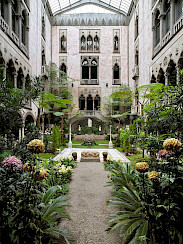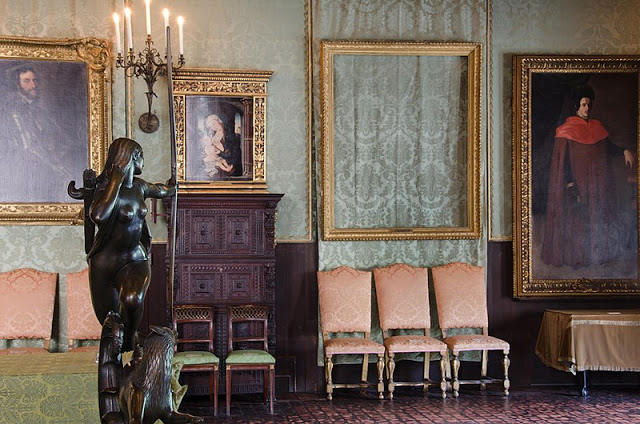The World's Largest Art Heist
The World’s Largest Art Theft 30 Years Later
When I think of Boston, I think of the brownstones on Beacon Hill, the winding neighborhood  streets of Little Italy, or the hip expanse of Faneuil Hall that is a perfect spot for foodies. What I didn’t expect was to be transported back to Venice in the middle of the city at the Isabella Stewart Gardner Museum. She is such an interesting woman of the world, I found her story inspiring and up-lifting…and her taste and home, that has been a museum since 1903 is impeccable.
streets of Little Italy, or the hip expanse of Faneuil Hall that is a perfect spot for foodies. What I didn’t expect was to be transported back to Venice in the middle of the city at the Isabella Stewart Gardner Museum. She is such an interesting woman of the world, I found her story inspiring and up-lifting…and her taste and home, that has been a museum since 1903 is impeccable.
Early Life of Isabella Stewart Gardner
Born in New York City in 1840 to a well to do Irish family in the linen importing business Isabella was educated privately in New York City and “finished” abroad. She was introduced to her husband, Jack Gardner by a close friend. They married in 1860 and moved to his home town of Boston.
After the death of her son in 1863, her husband Jack took Isabella to northern Europe and Russia in order to fight her depression. This was the first of many trips. They traveled all over Europe and the Middle East including Egypt and Asia. Back in Boston, she became a member of the Dante Society that was associated with the intellectual life of Boston. The Dante Society encouraged her to start collecting rare books and manuscripts leading to a life long passion for collecting rare and beautiful works of art and ephemera.
Venice and the Palazzo in Boston
Venice was one of Isabella’s and Jack’s favorite places to visit. They often frequented the Palazzo Barbaro, a Venetian Palace on the Grand Canal owned by friends from Boston. The Venice social scene was filled with famous luminaries such as painters John Singer Sargent, James McNeil Whistler, and Ralph Curtis. It was at this time, in 1886, that Isabella met Harvard student Bernard Berenson who became her art advisor and helped to inspire her collection that can be seen today at the museum. Isabella and Jack purchased columns, windows, balustrades, capitals, and statuary from Roman, Byzantine, Gothic, and Renaissance periods to adorn their new museum in Boston. After the sudden death of her husband, Jack in 1898, Isabella proceeded with their plans to build a Palazzo in Boston and construction began in 1899 and was completed in 1901. Isabella was an active participant in the construction of the marvelous edifice.
Isabella lived in her sumptuous apartments on the fourth floor and personally arranged the artwork in the galleries of the first three floors that consist of paintings, sculptures, tapestries, furniture, manuscripts, rare books, and decorative arts. She continued to collect and arrange for the rest of her life. She opened the museum to the public in 1903 and arranged concerts, lectures, and exhibitions for the next 20 years, a tradition that continues to this very day. She died in 1924 and left the museum “for education and enjoyment of the public forever.”
My favorite part of the Museum is the Courtyard and the way architectural elements, stone columns, and windows are seamlessly integrated into a beautiful and unforgettable garden space. The extraordinary way that the light is reflected here is often compared to the light that is reflected off the water of the Grand Canal in Venice. I felt transported to the Grand Canal!
Walking through the galleries that consist of more than 14,500 works of art that span the world from ancient Rome, Medieval Europe, Renaissance Italy, and Asia to the Islamic world and 19th century France and America in addition to 1500 rare books is mind-boggling. Exploring the 30 themed rooms is like walking through time and the world itself. Several of my favorites include the bright and airy Chinese Loggia Room with its’ ancient Roman elements and sculptures, the Dutch Room with so many missing pieces of art, the Little Salon with its beautiful furniture and decorative appointments, and the Veronese Room that includes paintings by Whistler.
The Heist
It happened thirty years ago, in March of 1990 and remains the largest unsolved art heist in history. In the early morning hours, 13 works of art were stolen in the single largest property theft in the world. The museum offers a fascinating audio tour that traces the steps of the thieves who got away with stealing these priceless works of art.
The heist began as the thieves slipped into the museum through a side door disguised as Boston police officers. They surprised the night guards and bound them with duct tape, then headed down the hallway. Motion detectors tracked the movements of the thieves that first headed to the Dutch room and stole three Rembrandts, a painting by Johannes Vermeer, another painting by Govaert Flinck, and an ancient Chinese Gu, the oldest work of art stolen. The next room that the thieves hit was the Short Gallery where they took five rare works by Degas. Their last stop was the Blue Room where they took a painting by Manet and on their way out they grabbed a bronze eagle finial dating to Napoleon’s First Regiment of Imperial Guard. It is enthralling and sad to trace the route of these notorious thieves on the audio tour - that gives you a good idea of the audacity of this crime!
The theft took 81 minutes, an eternity for a crime of this caliber. Theories abound and many have wondered if it was related to an inside job! The FBI believes that this theft is connected to Connecticut mobster, Robert Gentile as well as a mobster in the Boston area. In 2014, Daniel Turner, a suspect in this infamous case was released from prison after 21 years but he isn’t talking.
Taking this audio tour it is startling and a bleak reminder of the stolen paintings because their frames remain empty to this day. The estimates of the stolen works of art are valued at $500 plus million. Today, there is a ten million dollar reward for the recovery of these priceless works of art.
The Trip to the Scene of the Crime
Tours of Distinction is offering a very special 30 year anniversary day trip that commemorates this theft to the Isabella Stewart Gardner Museum. If you are a lover of whodunnits, the new Day Tour offered to small groups to the Isabella Steward Gardner Museum in Boston is not to be missed.

